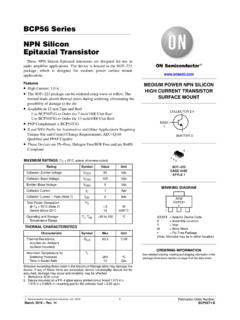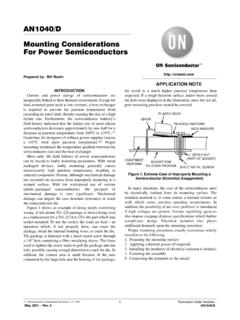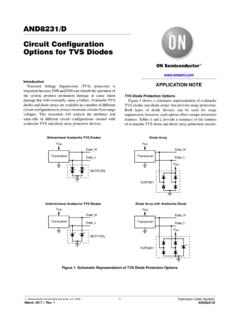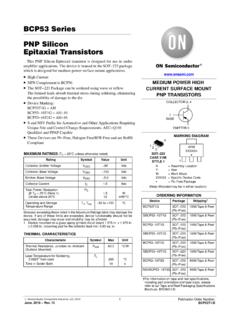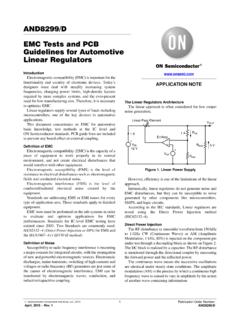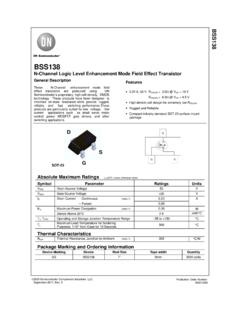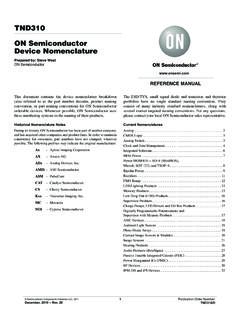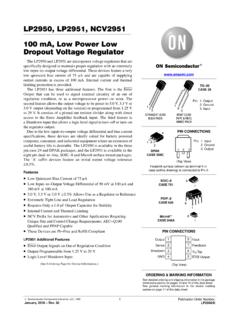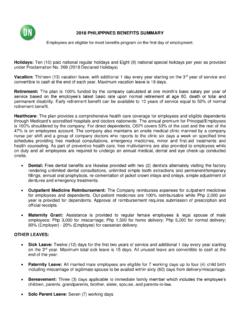Transcription of NCP3065 - Constant Current Switching Regulator
1 Semiconductor Components Industries, LLC, 2011 August, 2019 Rev. 41 Publication Order Number: NCP3065 /DNCP3065, NCV3065 Constant Current BuckBoosting Inverting SwitchingRegulator for AThe NCP3065 is a monolithic Switching Regulator designed todeliver Constant Current for powering high brightness LEDs. Thedevice has a very low feedback voltage of 235 mV (nominal) which isused to regulate the average Current of the LED string. In addition, theNCP3065 has a wide input voltage up to 40 V to allow it to operatefrom 12 Vac or 12 Vdc supplies commonly used for lightingapplications as well as unregulated supplies such as Lead Acidbatteries. The device can be configured in a controller topology withthe addition of an external transistor to support higher LED currentsbeyond the A rated switch Current of the internal transistor.
2 TheNCP3065 Switching Regulator can be configured in Step Down(Buck) and Step Up (boost) topologies with a minimum number ofexternal Integrated A Switch Input Voltage Range from V to 40 V Low Feedback Voltage of 235 mV Cycle by Cycle Current Limit No Control Loop Compensation Required Frequency of Operation Adjustable up to 250 kHz Operation with All Ceramic Output Capacitors or No Output Capacitance Analog and Digital PWM Dimming Capability Internal Thermal Shutdown with Hysteresis Automotive Version AvailableApplications Automotive and Marine Lighting High Power LED Driver Constant Current Source Low Voltage LED Lighting(Landscape, Path, Solar, MR16 Replacement)Figure 1. Typical Buck Application CircuitNCP3065 VinCin220 WNCIpkVinCOMPCout22 mFVth = nFCTDDD+LEDLLEDC luster WSWCSWEGNDCTRsRPDIP 8P, P1 SUFFIXCASE 626 8MN SUFFIXCASE 488 SOIC 8D SUFFIXCASE 75118 NCP3065 AWLYYWWGA= Assembly LocationL, WL= Wafer LotY, YY= YearW, WW= Work WeekG or G= Pb Free Package(Note: Microdot may be in either location)See detailed ordering and shipping information in the packagedimensions section on page 15 of this data INFORMATION3065 ALYWGG118 NCP3065 ALYW GG1 NCV3065 AWLYYWWGV3065 ALYWGG1 NCV3065 ALYW GGNCP3065, NCV3065 2.
3 Pin ConnectionsTiming SenseGNDS witch EmitterSwitch Collector(Top View)43215678 SenseTiming CapacitorGNDS witch EmitterSwitch Collector(Top View)Figure 3. Pin ConnectionsEP FlagFigure 4. Block DiagramREFERENCECOMPARATOR5 RSQSET dominant+ V+ 26 RSQ41 OSCILLATORS witch CollectorSwitch EmitterTiming CapacitorGNDC omparator Inverting Input+VCCIpk dominantPIN DESCRIPTIONPin NameDescription1 Switch CollectorInternal Darlington switch collector2 Switch EmitterInternal Darlington switch emitter3 Timing CapacitorTiming Capacitor Oscillator Input, Timing Capacitor4 GNDG round pin for all internal circuits5 ComparatorInverting InputInverting input pin of internal comparator6 VCCV oltage supply7 Ipk SensePeak Current Sense Input to monitor the voltage drop across an external resistor to limit the peakcurrent through the not connectedNCP3065, NCV3065 RATINGS (measured vs.)
4 Pin 4, unless otherwise noted)RatingSymbolValueUnitVCC (Pin 6)VCC0 to +40 VComparator Inverting Input (Pin 5)VCII to +VCCVD arlington Switch Collector (Pin 1)VSWC0 to +40 VDarlington Switch Emitter (Pin 2) (Transistor OFF)VSWE to +VCCVD arlington Switch Collector to Emitter (Pins 1 2)VSWCE0 to +40 VDarlington Switch Sense (Pin 7)VIPK to VCC + Capacitor (Pin 3)VTCAP to + Dissipation and Thermal CharacteristicsPDIP 8 Thermal Resistance Junction to AirRqJA100 C/WSOIC 8 Thermal Resistance Junction to AirRqJA180 C/WDFN 8 Thermal Resistance Junction to AirThermal Resistance Junction to CaseRqJARqJC7814 C/WStorage Temperature RangeTSTG 65 to +150 CMaximum Junction TemperatureTJ(MAX)+150 COperating Junction Temperature Range (Note 3) NCP3065 , NCV3065TJ 40 to +125 CStresses exceeding Maximum Ratings may damage the device.
5 Maximum Ratings are stress ratings only. Functional operation above theRecommended Operating Conditions is not implied. Extended exposure to stresses above the Recommended Operating Conditions may affectdevice This device series contains ESD protection and exceeds the following tests:Pin 1 8: Human Body Model 2000 V per AEC Q100 002; 003 or JESD22/A114; A115 Machine Model Method 200 V2. This device contains latch up protection and exceeds 100 mA per JEDEC Standard The relation between junction temperature, ambient temperature and Total Power dissipated in IC is TJ = TA + Rq PD4. The pins which are not defined may not be loaded by external signalsNCP3065, NCV3065 CHARACTERISTICS (VCC = V, TJ = 40 C to +125 C, unless otherwise specified)CharacteristicConditionsSymbol MinTypMaxUnitOSCILLATORF requency(VPin 5 = 0 V, CT = nF,TJ = 25 C)fOSC110150190kHzDischarge to Charge Current Ratio(Pin 7 to VCC, TJ = 25 C)IDISCHG Capacitor Discharging Current (Pin 7 to VCC, TJ = 25 C)IDISCHG1650mACapacitor Charging Current (Pin 7 to VCC, TJ = 25 C)ICHG275mACurrent Limit Sense Voltage(TJ = 25 C) (Note 6)VIPK(Sense)165185235mVOUTPUT SWITCH (Note 5)Darlington Switch Collector toEmitter Voltage Drop(ISW = A,TJ = 25 C) (Note 5)VSWCE(DROP) Off State Current (VCE = 40 V)IC(OFF) VoltageTJ = 25 CVTH235mVTJ = 0 to +85 C 5%TJ = 40 C to +125 CVTH 10+10%Threshold Voltage Line Regulation(VCC = V to 40 V)
6 REGLiNE Bias Current (Vin = Vth)ICII in 1000 1001000nATOTAL DEVICES upply Current (VCC = V to 40 V,CT = nF, Pin 7 = VCC,VPin 5 > Vth, Pin 2 = GND,remaining pins open) Shutdown Threshold160 CHysteresis10 C5. Low duty cycle pulse techniques are used during test to maintain junction temperature as close to ambient temperature as The VIPK(Sense) Current Limit Sense Voltage is specified at static conditions. In dynamic operation the sensed Current turn off value dependson comparator response time and di/dt Current slope. See the Operating Description section for NCV prefix is for automotive and other applications requiring site and change , NCV3065 5. Oscillator Frequency vs. OscillatorTiming CapacitorFigure 6. Oscillator Frequency vs. SupplyVoltageCt, CAPACITANCE (nF)VCC, SUPPLY VOLTAGE (V)402925161273110120130150160170180190 Figure 7.
7 Emitter Follower Configuration OutputDarlington Switch Voltage Drop vs. TemperatureFigure 8. Common Emitter Configuration OutputDarlington Switch Voltage Drop vs. TemperatureTJ, JUNCTION TEMPERATURE ( C)TJ, JUNCTION TEMPERATURE ( C)150100500 9. Emitter Follower Configuration OutputDarlington Switch Voltage Drop vs. Emitter CurrentFigure 10. Common Emitter ConfigurationOutput Darlington Switch Voltage Drop CurrentIE, EMITTER Current (A)IC, COLLECTOR Current (A) (kHz)FREQUENCY (kHz)213438140CT = nFTJ = 25 CVOLTAGE DROP (V)VCC = VIE = 1 AVOLTAGE DROP (V)VCC = VIC = 1 AVOLTAGE DROP (V)VOLTAGE DROP (V) = VTJ = 25 CVCC = VTJ = 25 C0501001502002503003504004500 1 2 3 4 5 6 7 8 9 10 11 12 1314 1516 1718 1920 NCP3065 , NCV3065 11. Comparator Threshold Voltage 12. Current Limit Sense Voltage , JUNCTION TEMPERATURE ( C)TJ, JUNCTION TEMPERATURE ( C)1103010150 30 10 25 13.
8 Standby Supply Current vs. Supply VoltageVCC, SUPPLY VOLTAGE (V) , COMPARATOR THRESHOLD VOLTAGE (V)Vipk(sense), Current LIMIT SENSEVOLTAGE (V)2095 , SUPPLY Current (mA)CT = nFPin 5, 7 = VCCPin 2 = GND , NCV3065 NCP3065 is a monolithic power Switching regulatoroptimized for LED Driver applications. Its flexiblearchitecture enables the system designer to directlyimplement a step up or step down topology with aminimum number of external components for driving representative block diagram is shown in Figure DESCRIPTIONThe NCP3065 operates as a fixed oscillator frequencyoutput voltage ripple gated Regulator . In general, this modeof operation is somewhat analogous to a capacitor chargepump and does not require dominant pole loopcompensation for converter stability.
9 The typical operatingwaveforms are shown in Figure 14. The output voltagewaveform shown is for a step down converter with theripple and phasing exaggerated for clarity. During initialconverter startup, the feedback comparator senses that theoutput voltage level is below nominal. This causes theoutput switch to turn on and off at a frequency and duty cyclecontrolled by the oscillator, thus pumping up the output filtercapacitor. When the feedback voltage level reaches nominalcomparator value, the output switch cycle is inhibited. Whenthe load Current causes the output voltage to fall below thenominal value feedback comparator enables switchingimmediately. Under these conditions, the output switchconduction can be enabled for a partial oscillator cycle, apartial cycle plus a complete cycle, multiple cycles, or apartial cycle plus multiple oscillator frequency and off time of the output switchare programmed by the value of the timing capacitor CT is charged and discharged by a 1 to 6 ratiointernal Current source and sink, generating a positive goingsawtooth waveform at Pin 3.
10 This ratio sets the maximumtON/(tON+tOFF) of the Switching converter as 6/(6+1) (typical). The oscillator peak and valley voltagedifference is 500 mV typically. To calculate the CT capacitorvalue for required oscillator frequency, use the equationsfound in Figure 22. An online NCP3065 design tool can befound at , which adds in selectingcomponent 14. Typical Operating Waveforms10 Output Switch10 OnOffFeedback Comparator OutputNominal Output Voltage LevelStartupOperationOutput VoltageTiming Capacitor, CTIPK Comparator OutputNCP3065, NCV3065 Current Sense ComparatorUnder normal conditions, the output switch conduction isinitiated by the Voltage Feedback comparator andterminated by the oscillator. Abnormal operating conditionsoccur when the converter output is overloaded or whenfeedback voltage sensing is lost.
